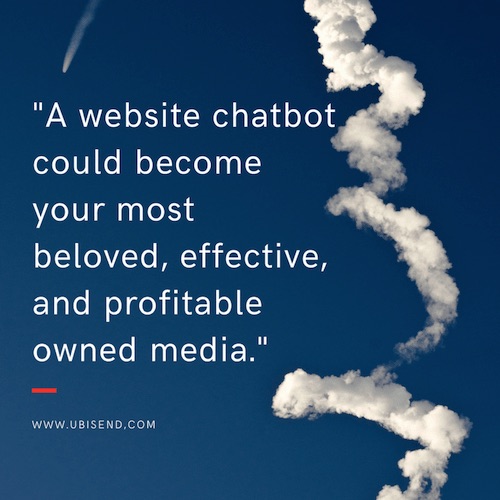A Chatbot on Your Website: The Ultimate Owned Asset

Customers are always better served now and then. This is, at large, the power of chatbots. They allow businesses to catch up with the 'right here right now' consumer trend.
'Right here right now' often means on your website.
In this article, we will see why a website chatbot could become your most beloved, effective, and profitable asset.
Where do chatbots live?
Over the last couple of years, it seems every single platform has evolved to welcome chatbots. Almost all but WhatsApp for now allow chatbot development (Editor's note: as of Jan 19, 2018, WhatsApp have made progress on this front! Read our report on the WhatsApp for Business release).
But, aside from this one, chatbots can live everywhere.
It's easy to think all chatbots should live on Facebook Messenger. However, depending on where you are in the world, Messenger may not be your best bet. For example, in the East and Asia, you would have much better luck with WeChat.
But, what about websites?
A chatbot on your own property
A chatbot can, of course, live on your website.
Most of our clients deploy web chatbot solutions, whether that is on their customer-facing or internal portals. The reasoning is simple: that's where their users (i.e. customers or employees) are.
It is quite common to believe chatbots can only live on messaging platforms. Some clients actually ask us if 'that would be possible', and are surprised to hear it's the easiest thing in the world.

We deploy chatbots using a single, simple line of code in the header of your website. Once that's done and published, a web widget appears on the website and off you go. Easy peasy.
Is it the best option for you? Let us look at a few pros and cons of having a chatbot live straight on your website.
The pros and cons of a chatbot on your website
PROS
- There and then: we are back at the start of this article. The number one advantage of your chatbot living on your website is that it is there to help now. Don't send people to your Facebook Messenger. Don't ask them to call you or text you. Help them there.
- Owned media: whatever platform you use has first dibs on your data. You don't truly own the channel. If you use Facebook Messenger, Facebook will get the data that goes through your chatbot. No way around it. On the other hand, an on-site chatbot is owned media. Your data goes to you and no one else.
- Full control: again, if you rely on another platform you don't control some of the chatbot's aspects. For instance, you can't change the layout of a Telegram chat window. You can't change the colours of a Facebook Messenger button. You can't create a new rich media snippet on a Line chatbot. All this is possible through your own, proprietary on-site chatbot.
Cons
- People need to find your site: there is no way around it. It's great to leverage other platforms because they bring a new stream of users. With an on-site chatbot, you can't rely on that. You have to build your own audience.
- Potential interruption: some of us get annoyed by these little bottom right corner bubbles asking if we need help. Your chatbot could interrupt a perfectly normal web browsing experience. If you realise your chatbot is interrupting and bothering users, though, I would suggest you dig deeper into its UX. There is most likely something wrong in the way the chatbot interacts with its users, when it pops up, where it appears, etc.
Keep the data in-house
So here is the deal.
An on-site chatbot is fantastic opportunity to keep everything in-house. You keep control over its appearance, its functionalities, when it appears or not, and much more.
On top of that, you also keep the data for yourself. You don't fling any information to third-parties.
Does this mean all chatbots should be onsite? Of course not! As with any digital asset, you must evaluate how to best serve your audience. If your audience is 10 to 15-year-olds in Europe, chances are they don't browse the internet much -- get them through Kik or Instagram.
There are many added benefits to using your own website as the hosting platform for your bot. Think of your ideal user story, where they interact with your brand, and where they are most likely to get lost. If that is on your site, you will find great value in offering them help via a chatbot.












